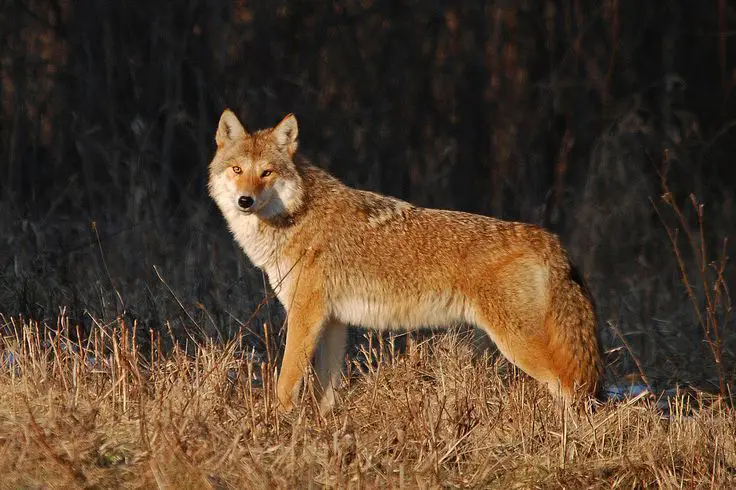Is There A Red Coyote?
The question of whether there is a red coyote is an intriguing one for wildlife enthusiasts and scientists alike. Coyotes typically have grayish-brown or yellowish-gray fur, so a red-colored coyote would be highly unusual. Determining if red coyotes exist provides insight into coyote genetics, evolution, and adaptations. Additionally, documenting the existence of morphs like red coyotes is important for conservation efforts. Overall, investigating the possibility of red coyotes offers a fascinating look into coyote diversity and raises scientific questions about what causes unusual coat colorings in canids.
Typical Coyote Colorings
Coyotes typically have thick, bushy fur that helps them retain body heat in cold weather. Their coats are predominantly light gray and red or fulvous interspersed with some black and white hairs. Geographical location can affect the exact coloring. For example, coyotes in desert areas tend to have more white areas in their fur, while forest coyotes are often darker. Coyotes also have darker colored bands or streaks along their legs and backs.
Coyotes have a signature winter coat that usually includes a crescent-shaped pattern of black and white hairs on their chests and shoulders. This coat is thick and fluffy and helps insulate them against harsh winter weather. Their summer coats tend to be thinner and shorter.
According to Wikipedia, “Their fur color is predominantly light gray and red or fulvous interspersed with black and white, though it varies somewhat with geography.” (https://en.wikipedia.org/wiki/Coyote)
Causes of Red Coloring in Coyotes
The red or brown coloring seen in some coyotes is caused by a combination of genetic and environmental factors. Coyotes typically have gray, tan, or brown fur, but recessive genes can produce reddish fur. These genes are thought to originate from past hybridization between coyotes and red wolves, according to one source (https://wildlife.org/red-wolf-ghost-genes-linger-in-coyote-descendants/). When two coyotes carrying the recessive red gene breed, they can produce red-coated offspring. The red coloration is also enhanced by environmental conditions – coyotes living in more open, drier areas with more sun exposure tend to have redder coats.

While gray is the most common coyote fur color, the frequency of red coyotes appears to be increasing in certain areas like Louisiana. Scientists believe introgression from red wolves contributed ghost alleles which resurface intermittently, producing more reddish coyotes. The red wolf genes still persist within the coyote population and can be expressed under the right genetic and environmental circumstances.
Distribution of Red Coyotes
Red coyotes are predominantly found in the southeastern United States, including parts of North Carolina, South Carolina, Virginia, Florida, Louisiana, and Texas. Based on research, red coyotes seem to be most concentrated in coastal regions of North Carolina and Texas.
One study analyzing the distribution of red coyotes found that the highest densities occur along the coastlines and barrier islands of North Carolina, particularly in Dare, Hyde, and Tyrrell counties (https://en.wikipedia.org/wiki/Red_wolf). These counties encompass the Outer Banks region where red coyotes are frequently documented.
In Texas, red coyotes have been observed in counties bordering the Gulf of Mexico such as Galveston, Matagorda, Calhoun, and Refugio. TheSemi-arid regions of southern Texas also support red coyote populations.
While less common, red coyotes have also been spotted in other coastal states including South Carolina around the Cape Romain region and in parts of southern Louisiana near the Mississippi River Delta.
Overall, coastal habitats with access to marshland seem to provide ideal terrain for red coyotes, which may explain their concentrated presence along the Atlantic and Gulf coasts.
Red Coyote Population Size
According to https://esajournals.onlinelibrary.wiley.com/doi/full/10.1002/ecs2.4216, the prevalence of red coyotes within any particular area varies based on coyote population density as well as availability of food. Due to interbreeding with remnant red wolf populations, red coloring can emerge in coyote populations, though actual numbers are difficult to determine.
Researchers have estimated the total coyote population in the United States to be between 1 million to 10 million. However, the percentage of those that exhibit reddish fur is uncertain. One study in North Carolina found that only around 3-4% of the coyote population in the red wolf recovery area showed genetic evidence of hybridization with red wolves. This suggests red coyotes may only make up a very small fraction of the total coyote population.
Overall estimates put the number of red coyotes in the hundreds or low thousands at most. They do not comprise a major portion of coyote populations, though localized densities may be higher in certain regions where past interbreeding with red wolves occurred.
Behaviors of Red Coyotes
Red coyotes exhibit some behavioral differences compared to their non-red counterparts. According to research at the University of North Carolina [1], red coyotes tend to be more timid and wary of humans. They are also more likely to avoid developed areas and have larger home ranges due to their need for larger hunting territories. Red coyotes have been observed hunting alone and in pairs more often than in packs like grey coyotes do.
One key behavioral difference is that red coyotes breed later in the season compared to grey coyotes. This is likely an adaptive behavior to avoid competition and hybridization with grey coyotes. Red coyotes also are quieter and do not yip or howl as frequently as grey coyotes. In terms of interactions with other wildlife, red coyotes have been documented avoiding wolves when they share territory. Overall, the shy and elusive nature of red coyotes sets them apart behaviorally from grey coyotes.
Red Coyote Interactions with Other Wildlife
Red coyotes interact with a variety of other wildlife species. They often compete with smaller predators like red foxes for food sources such as rodents, rabbits, and other small mammals (Coyote Ecology Observations). Red foxes tend to hunt smaller prey while coyotes can take down larger animals, so there is some resource partitioning between the two species. However, dietary overlap does occur which can lead to interference competition.
Coyotes also coexist in many areas with larger predators like wolves, bears, and mountain lions. Wolves are dominant over coyotes and will kill them given the chance, so coyotes tend to avoid areas frequented by wolf packs (Coyote Relationships). With bears and mountain lions, there is less direct competition as they hunt even larger prey than coyotes. But they will opportunistically kill coyotes, so vigilance is required. Overall, red coyotes have adapted to carve out niches alongside a wide array of other predators across their range.
Red Coyote Conservation Status
As a type of coyote, the red coyote is not considered an endangered or threatened species. According to the International Union for Conservation of Nature (IUCN), the coyote is listed as least concern due to its wide distribution and abundance throughout North America. The IUCN last assessed the coyote’s conservation status in 2008.
However, some states do have special regulations regarding red coyotes due to the potential for misidentification with the federally endangered red wolf. For example, in North Carolina where the last wild population of red wolves exists, the state wildlife agency provides guidance on how to distinguish between red wolves and red coyotes to avoid accidentally shooting the protected wolves. Red coyotes in North Carolina may be legally hunted during the regulated coyote hunting season.
In areas outside of the red wolf’s current range like California and Texas, there are no special conservation rules for red coyotes. They are treated like typical coyotes from a hunting and management perspective. Overall, the red coloration does not affect the coyote’s conservation status unless they are in territories shared with the endangered red wolf.
Cultural Significance of Red Coyotes
The coloration of red coyotes holds special meaning in many Native American cultures. In Native American mythology and folklore, the coyote is often portrayed as a clever and mischievous animal. The reddish fur of some coyotes may symbolize this trickster nature.
According to some tribes, a red coyote sighting can signify sacred messages or warnings. For example, the Zuni and Pueblo peoples view the red coyote as a sacred messenger who bridged the gap between the spiritual and earthly realms. Seeing a red coyote may indicate that one needs to pay attention to omens or signs around them (Source).
In Navajo culture, spotting a red coyote is considered an ill omen, as red is linked with danger and death. However, other tribes like the Hopi associate them with healing powers. Overall, across various Native American belief systems, the red coyote holds unique symbolic meaning related to its reddish fur coloration.
Conclusion
In summary, the existence of truly red-colored coyotes is unproven, with most seeming cases likely being coyotes with standard colorations appearing more reddish due to factors like coat variations, lighting conditions, or rust stains. While some anomalous red coyotes may rarely occur, most evidence indicates they do not comprise a distinct population. Coyotes exhibit diverse color patterns, but red is not a standard morph. Confirmed cases of red coyotes are extremely rare. Some cultural legends reference red coyotes, but their symbolic meaning remains contested. While red coyotes generate curiosity, current research does not indicate they represent a distinct species or subpopulation. The topic requires more scientific study to fully understand if and why red coyotes sometimes appear. In conclusion, the evidence for a distinct group of red coyotes is limited at this time, but more research could uncover new details about these elusive canids and their origins.



